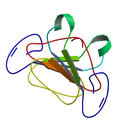| Record Information |
|---|
| Version | 2.0 |
|---|
| Creation Date | 2009-07-03 22:19:05 UTC |
|---|
| Update Date | 2014-12-24 20:25:38 UTC |
|---|
| Accession Number | T3D2510 |
|---|
| Identification |
|---|
| Common Name | alpha-Cobratoxin |
|---|
| Class | Protein |
|---|
| Description | alpha-Cobratoxin is a peptide toxin produced by certain cobras of the Naja genus, such as the Monocled cobra (Naja kaouthia). It is a muscle-type nicotinic acetylcholine receptor (nAChR) antagonist, which causes paralysis by preventing the binding of acetylcholine to the nAChR. (1) |
|---|
| Compound Type | - Amide
- Amine
- Animal Toxin
- Lachrymator
- Natural Compound
- Organic Compound
- Protein
- Snake Venom
|
|---|
| Protein Structure |  |
|---|
| Synonyms | | Synonym | | a-Cobratoxin | | Alpha-CbT | | Alpha-elapitoxin-Nk2a | | Alpha-EPTX-Nk2a | | Cbtx | | Long neurotoxin 1 | | Neurotoxin 3 |
|
|---|
| Chemical Formula | Not Available |
|---|
| Average Molecular Mass | 7830.960 g/mol |
|---|
| CAS Registry Number | 769933-79-1 |
|---|
| Sequence | Not Available |
|---|
| Chemical Taxonomy |
|---|
| Description | Not Available |
|---|
| Kingdom | Organic Compounds |
|---|
| Super Class | Organic Acids |
|---|
| Class | Carboxylic Acids and Derivatives |
|---|
| Sub Class | Amino Acids, Peptides, and Analogues |
|---|
| Direct Parent | Peptides |
|---|
| Alternative Parents | Not Available |
|---|
| Substituents | Not Available |
|---|
| Molecular Framework | Not Available |
|---|
| External Descriptors | Not Available |
|---|
| Biological Properties |
|---|
| Status | Detected and Not Quantified |
|---|
| Origin | Exogenous |
|---|
| Cellular Locations | - Cytosol
- Extracellular
- Membrane Fraction
- Mitochondrion
- Plasma Membrane
|
|---|
| Biofluid Locations | Not Available |
|---|
| Tissue Locations | Not Available |
|---|
| Pathways | | Name | SMPDB Link | KEGG Link |
|---|
| Apoptosis | Not Available | map04210 |
|
|---|
| Applications | Not Available |
|---|
| Biological Roles | Not Available |
|---|
| Chemical Roles | Not Available |
|---|
| Physical Properties |
|---|
| State | Liquid |
|---|
| Appearance | Clear solution. |
|---|
| Experimental Properties | | Property | Value |
|---|
| Melting Point | Not Available | | Boiling Point | Not Available | | Solubility | >10 mg/mL | | LogP | Not Available |
|
|---|
| Predicted Properties | Not Available |
|---|
| Spectra |
|---|
| Spectra | | Spectrum Type | Description | Splash Key | Deposition Date | View |
|---|
|
|---|
| Toxicity Profile |
|---|
| Route of Exposure | Injection (sting/bite) (3) |
|---|
| Mechanism of Toxicity | alpha-Cobratoxin is a muscle-type nicotinic acetylcholine receptor (nAChR) antagonist. It causes paralysis by preventing the binding of acetylcholine to the nAChR, as the nAChR is needed for synaptic transmission both in the central nervous system and at the neuromuscular junction. (1) |
|---|
| Metabolism | Free toxin may be removed by opsonization via the reticuloendothelial system (primarily the liver and kidneys) or it may be degraded through cellular internalization via the lysosomes. Lysosomes are membrane-enclosed organelles that contain an array of digestive enzymes, including several proteases. |
|---|
| Toxicity Values | LD50: 4 ug/kg (Mouse) (1) |
|---|
| Lethal Dose | Not Available |
|---|
| Carcinogenicity (IARC Classification) | No indication of carcinogenicity to humans (not listed by IARC). |
|---|
| Uses/Sources | alpha-Cobratoxin is a peptide toxin produced by certain cobras of the Naja genus, such as the Monocled cobra (Naja kaouthia). (1) |
|---|
| Minimum Risk Level | Not Available |
|---|
| Health Effects | Naja cobras have a strongly neurotoxic venom, which attacks the nervous system, causing paralysis, and many also have hemotoxic features which causes swelling, necrosis and has a significant anticoagulant effect. Naja bites can be fatal to humans. (2) |
|---|
| Symptoms | Naja bites cause pain and swelling at the site of the bite. The venom is alsoa severe irritant to the skin and eyes. (2) |
|---|
| Treatment | Not Available |
|---|
| Normal Concentrations |
|---|
| Not Available |
|---|
| Abnormal Concentrations |
|---|
| Not Available |
|---|
| External Links |
|---|
| DrugBank ID | Not Available |
|---|
| HMDB ID | Not Available |
|---|
| PubChem Compound ID | 16132280 |
|---|
| ChEMBL ID | Not Available |
|---|
| ChemSpider ID | 17288939 |
|---|
| KEGG ID | Not Available |
|---|
| UniProt ID | P01391 |
|---|
| OMIM ID | |
|---|
| ChEBI ID | Not Available |
|---|
| BioCyc ID | Not Available |
|---|
| CTD ID | Not Available |
|---|
| Stitch ID | alpha-Cobratoxin |
|---|
| PDB ID | 1CTX |
|---|
| ACToR ID | Not Available |
|---|
| Wikipedia Link | Not Available |
|---|
| References |
|---|
| Synthesis Reference | Not Available |
|---|
| MSDS | T3D2510.pdf |
|---|
| General References | - Wikipedia. Cobratoxin. Last Updated 23 May 2009. [Link]
- Wikipedia. Naja. Last Updated 6 July 2009. [Link]
- Wikipedia. Snake venom. Last Updated 25 July 2009. [Link]
|
|---|
| Gene Regulation |
|---|
| Up-Regulated Genes | | Gene | Gene Symbol | Gene ID | Interaction | Chromosome | Details |
|---|
|
|---|
| Down-Regulated Genes | | Gene | Gene Symbol | Gene ID | Interaction | Chromosome | Details |
|---|
|
|---|

